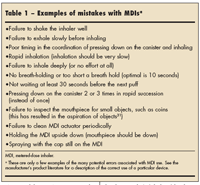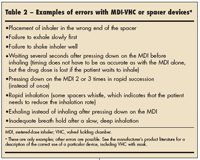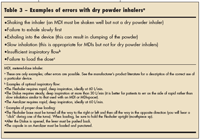- Clinical Technology
- Adult Immunization
- Hepatology
- Pediatric Immunization
- Screening
- Psychiatry
- Allergy
- Women's Health
- Cardiology
- Pediatrics
- Dermatology
- Endocrinology
- Pain Management
- Gastroenterology
- Infectious Disease
- Obesity Medicine
- Rheumatology
- Nephrology
- Neurology
- Pulmonology
MDIs, Spacers, and Dry Powder Inhalers: What Patients Are Likely to Do Wrong
Inhaled medications are the cornerstoneof therapy for most of themore than 30 million Americanswho have asthma or chronic obstructivepulmonary disease(COPD). Unfortunately, many ofthese patients use aerosol deliverydevices incorrectly.
Inhaled medications are the cornerstone of therapy for most of the more than 22 million Americans who have asthma, including 6 million children. Unfortunately, many of these patients use aerosol delivery devices incorrectly. Here we present common errors that have been described in the literature and that we have observed in our own practices. We also discuss strategies to improve patients’ technique.
FAULTY TECHNIQUE
MDIs. The frequent inappropriate use of metered-dose inhalers (MDIs) by patients has been well documented in the literature for more than 30 years.1-4 In some studies, as many as 89% of patients use MDIs incorrectly.1,2Table 1 lists some of the most common mistakes.

Valved holding chambers and spacers. These accessory devices enhance the efficacy of treatment and lower the risk of oropharyngeal candidiasis associated with inhaled corticosteroids.5,6 Spacers reduce the need for precise coordination between MDI actuation and inhalation, but errors can still occur (Table 2).7-10 Repeated instruction is documented to reduce errors in children.11
Dry powder inhalers. Breathactivated dry powder inhalers eliminate one of the most common problems in using MDIs: the timing of pressing down on the canister and beginning a slow, deep inhalation. Although these devices reduce the likelihood of error, some patients use them incorrectly.12,13
Dry powder inhalers do not require shaking; however, the patient must load the dose, exhale first away from the inhaler (ie, not into the dry powder), inhale with adequate inspiratory flow to ensure good pulmonary deposition, and hold the breath. In one study, children younger than 8 years had difficulty in generating sufficient inspiratory flow with the Turbuhaler (now Flexhaler).13 Lower-resistance devices such as the Diskus are approved for use in children as young as 4 years. Each step in using dry powder inhalers presents the opportunity for error (Table 3).

The design of currently used dry powder inhalers (eg, the Diskus, Flexhaler, Twisthaler, and Aerolizer) has improved on that of older devices, such as the Spinhaler and Rotahaler. For example, the Spinhaler was modified in design after a single report of near choking with the original device.14 In addition, the cromolyn powder used in the Spinhaler was frequently irritating to the airways; the currently available dry powder inhalers have very fine powders that are usually well tolerated.
PATIENT EDUCATION IS KEY
Incorrect use of inhalation devices is associated with a suboptimal response to therapy.15,16 Thus, teaching patients how to use these devices correctly is essential to ensure optimal outcomes. National and international guidelines for the treatment of asthma emphasize the absolute necessity of patient education. 17,18 Detailed and repetitive instruction- as outlined in the National Asthma Education and Prevention Program Expert Panel Report 3: Guidelines for the Diagnosis and Management of Asthma17-is associated with a reduction in emergency department visits and hospitalizations. 19

Such instruction must include observation of patient use as well as demonstrations of correct use. Furthermore, the patient’s technique must be observed regularly-ideally at each office visit.
In addition to the lack of patient skill in the use of MDIs and other inhalation devices, several studies clearly document poor technique among many physicians and medical students, as well as pharmacists and nurses.20-27 Ensure that at least one staff member in your office is welltrained and competent to instruct patients on the proper use of inhalation devices. Further, the national guidelines recommend that the “principal clinician” introduce key educational messages and that these messages be reinforced and expanded on by all members of the health care team.17,18 For example, pharmacists who are properly trained in the correct use of inhalation devices can be important contributors to patient education and other key components of asthma care.19,28
Finally, efficacy of fluticasone via MDI plus valved holding chamber with mask has been demonstrated for children aged 2 to 4 years.29 While many preschool children may require a nebulizer, many others can use an MDI plus valved holding chamber with mask or a dry powder inhaler. As mentioned previously, some dry powder inhalers can be used by age 4 years, while others are better suited for patients 8 years and older. Device selection should be individualized, and comprehensive evidence-based guidelines are available.30
References:
REFERENCES:
1.
Epstein SW, Manning CP, Ashley MJ, Corey PN.Survey of the clinical use of pressurized aerosolinhalers.
Can Med Assoc J
. 1979;120:813-816.
2.
Hartert TV, Windom HH, Peebles RS Jr, et al.Inadequate outpatient medical therapy for patientswith asthma admitted to two urban hospitals.
Am JMed
. 1996;100:386-394.
3.
Shim C, Williams MH. The adequacy of inhalationof aerosol from canister nebulizers.
Am J Med
.1980;69:891-894.
4.
Newman SP, Pavia D, Clarke SW. How should apressurized beta-adrenergic bronchodilator beinhaled?
Eur J Respir Dis
. 1981;62:3-21.
5.
Toogood JH, Baskerville J, Jennings B, et al.Use of spacers to facilitate inhaled corticosteroidtreatment of asthma.
Am Rev Respir Dis
. 1984;129:723-729.
6.
Salzman GA, Pyszczynski DR. Oropharyngealcandidiasis in patients treated with beclomethasonedipropionate delivered by metered-dose inhaleralone and with Aerochamber.
J Allergy Clin Immunol
.1988;81:424-428.
7.
Rachelefsky GS, Rohr AS, Wo J, et al. Use of atube spacer to improve the efficacy of a metereddoseinhaler in asthmatic children.
Am J Dis Child
.1986;140:1191-1193.
8.
Demirkan K, Tolley E, Mastin T, et al. Salmeteroladministration by metered-dose inhaler alone vsmetered-dose inhaler plus valved holding chamber.
Chest
. 2000;117:1314-1318.
9.
Pedersen S, Ostergaard PA. Nasal inhalation as acause of inefficient pulmonary aerosol inhalationtechnique in children.
Allergy
. 1983;38:191-194.
10.
Dolovich M, Chambers C. Effect of a pauseprior to inhaling a MDI aerosol on drug availabilitythrough an open tube spacer [abstract].
J AllergyClin Immunol
. 1994;93:169.
11.
Kamps AW, Brand PL, Roorda RJ. Determinants of correct inhalation technique in children attending a hospital-based asthma clinic.
Acta Paediatr.
2002;91:159-163.
12.
van Beerendonk I, Mesters I, Muddle AN,Tan TD. Assessment of the inhalation technique inoutpatients with asthma or COPD using a metereddoseinhaler or dry powder device.
J Asthma
. 1998;35:273-279.
13.
De Boeck K, Alifier M, Warnier G. Is the correctuse of a dry powder inhaler (Turbohaler) agedependent?
J Allergy Clin Immunol
. 1999;103:763-767.
14.
Self TH. Another cause of choking.
N Engl JMed
. 1976;295:174.
15.
Giraud V, Roche N. Misuse of corticosteroidmetered-dose inhaler is associated with decreasedasthma stability.
Eur Respir J
. 2002;19:246-251.
16.
Lindgren S, Bake B, Larsson S. Clinical consequencesof inadequate inhalation technique in asthmatherapy.
Eur J Respir Dis
. 1987;70:93-98.
17.
Expert Panel Report 3: Guidelines for the Diagnosisand Management of Asthma
. Bethesda, Md: NationalInstitutes of Health; 2007. NIH PublicationNo. 07-4051.
http://www.nhlbi.nih.gov
.
18.
Global Initiative for Asthma.
Global Strategy for Asthma Management and Prevention.
Updated December 2008.
http://www.ginasthma.org
.
19.
Self TH, Chrisman CR, Mason DL, Rumbak MJ. Reducing emergency department visits and hospitalization in African American and Hispanic patients with asthma: a 15-year review.
J Asthma
. 2005;42:807-812.
20.
Kelling JS, Strohl KP, Smith RL, Altose MD.Physician knowledge in the use of canister nebulizers.
Chest
. 1983;83:612-614.
21.
Burton AJ. Asthma inhalation devices: what dowe know?
BMJ
. 1984;288:651-652.
22.
Self TH, Arnold LB, Czosnowski LM, et al. Inadequate skill of healthcare professionals in using asthma inhalation devices.
J Asthma
. 2007;44:593-598.
23.
Interiano B, Guntupalli KK. Metered-dose inhalers:do health care providers know what toteach?
Arch Intern Med
. 1993;153:81-85.
24.
Hanania NA, Wittman R, Kesten S, ChapmanKR. Medical personnel’s knowledge of and ability touse inhaling devices. Metered-dose inhalers,spacing chambers, and breath-actuated dry powderinhalers.
Chest
. 1994;105:111-116.
25.
Self TH, Kelso TM, Arheart KL, et al. Nurses’performance of inhalation technique with metereddoseinhaler plus spacer device.
Ann Pharmacother
.1993;27:185-187.
26.
Kesten S, Zive K, Chapman KR. Pharmacistknowledge and ability to use inhaled medication deliverysystems.
Chest
. 1993;104:1737-1742.
27.
Chafin CC, Tolley E, Demirkan K, et al. Effect ofa brief educational intervention on medical students’use of asthma devices.
J Asthma
. 2000;37:585-588.
28.
Self TH, Brooks JB, Lieberman P, Ryan MR.The value of demonstration and role of the pharmacistin teaching the correct use of pressurized bronchodilators.
Can Med Assoc J
. 1983;128:129-131.
29.
Wasserman RL, Baker JW, Kim KT, et al. Efficacy and safety of inhaled fluticasone propionate chlorofluororcarbon in 2- to 4-year-old patients with asthma: results of a double-blind, placebo-controlled study.
Ann Allergy Asthma Immunol.
2006;96:808-818.
30.
Dolovich MB, Ahrens RC, Hess DR, et al. Device selection and outcomes of aerosol therapy: Evidence-based guidelines: American College of Chest Physicians/American College of Asthma, Allergy, and Immunology.
Chest.
2005;127:335-371.
31.
Schultz CH, Hargarten SW, Babbitt J. Inhalationof a coin and a capsule from metered-dose inhalers.
N Engl J Med
. 1991;325:431-432.
